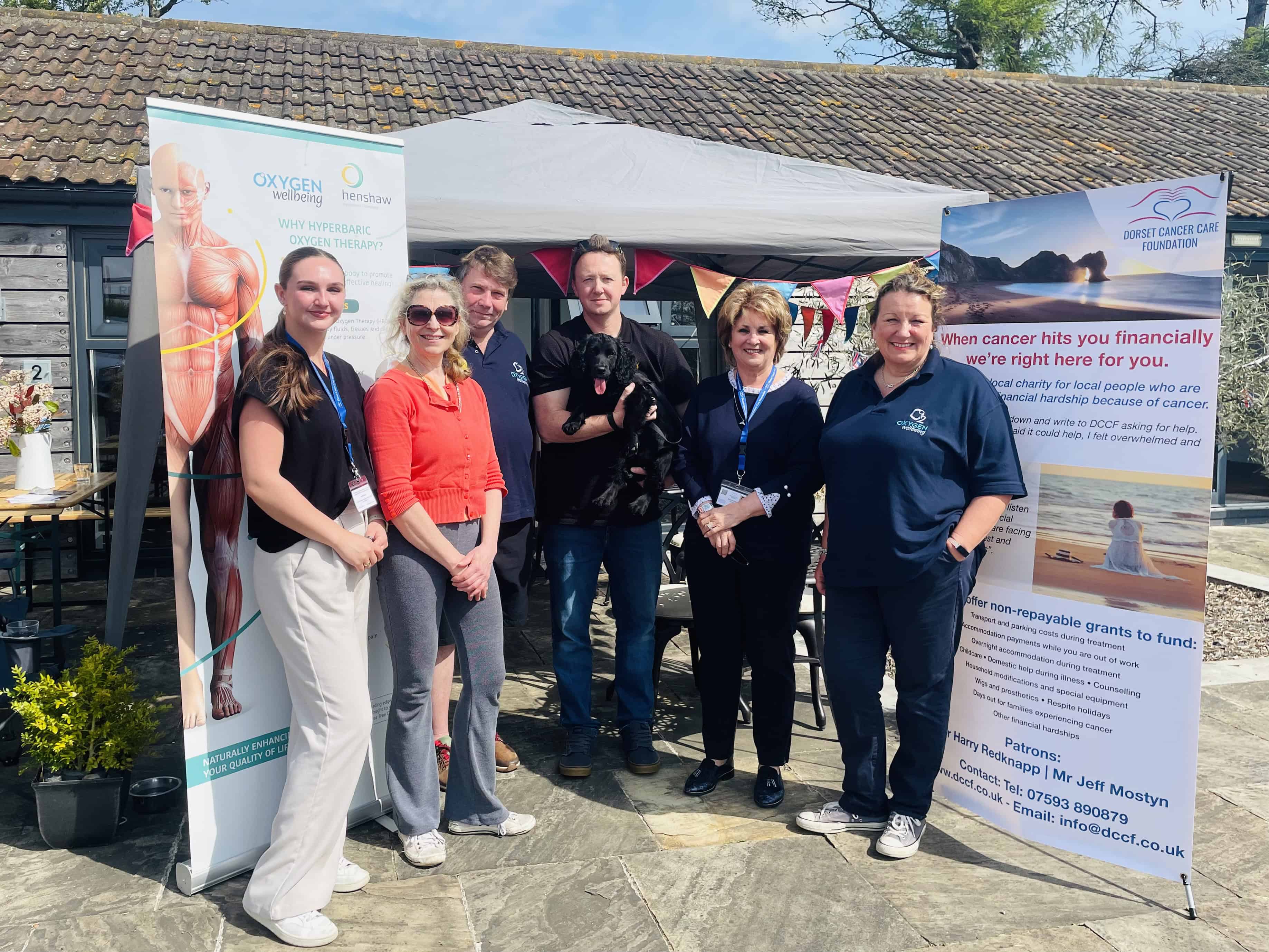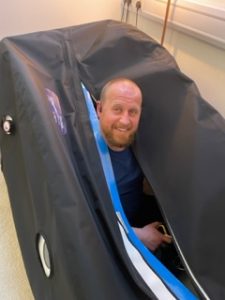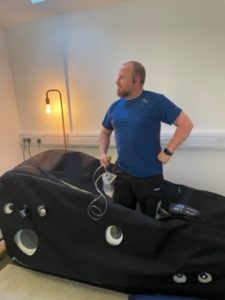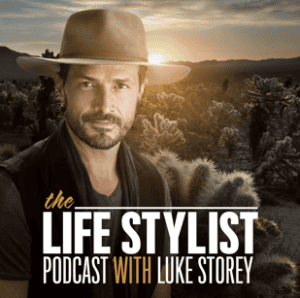A Sherborne clinic which offers Hyperbaric Oxygen Therapy hosted a coffee morning to help a Dorset cancer charity.

SUPPORTERS – left to right – Jazmine White Charity manager of the DCCF, Emma Rhys Thomas, , Steve Thornton, Co- owner of Oxygen Wellbeing, Nick Ackland, Meryl Ponsford, DCCF Trustee and Juliet Thornton, Co- owner of Oxygen Wellbeing.
Oxygen Wellbeing at West Down Farm in Corton Denham, reached out to help after learning of the Dorset Cancer Care Foundation’s (DCCF) wish to help more people in the north of the county.
Oxygen Wellbeing is owned by Juliet and Steve Thornton from Wincanton.
Steve is a retired Metropolitan Firearms Officer and the couple set up the business largely because of Steve’s ongoing work with people from Blue light and military backgrounds who suffer from Post -Traumatic Stress Disorder (PTSD).
Hyperbaric Oxygen Therapy – or HBOT – sees users breathe 95 per cent oxygen within a pressurised hyperbaric chamber. The drug-free therapy helps the body heal from injury or surgery as well as relieves pain and reduces inflammation in conditions such as Arthritis, Long Covid and Multiple Sclerosis. Well known among professional sports clubs and high profile celebrities; this is now available in the West Country for anyone looking to repair or enhance their general health.
Juliet explained: “We are privileged to be helping some local cancer patients, so, when we heard that the DCCF was trying to publicise its work in and around Sherborne we were keen to help.”
The DCCF helps Dorset people and their families who are experiencing financial hardship because of a cancer diagnosis.
The charity’s non-refundable grants are used by recipients to pay for costs such as travel to and from their hospital treatment, household costs, childcare and respite breaks.
Funded entirely by supporters and events, since 2010 the DCCF has given over £663,000 to 760 individuals and organisations.
Oxygen Wellbeing’s DCCF Coffee Morning raised over £135.00.
Steve said: “We were blessed with great weather and great company and as well as raising funds for the charity, Jaz and Meryl were able to share valuable information about the charity to our visitors. We also had a raffle which was kindly supported with some great prizes from local businesses.”
Jazmine White, charity manager for the DCCF said: “We were delighted when Juliet and Steve offered to raise money and awareness for the charity.
“The DCCF is making a real difference to the lives of people with cancer in the east of the county and we would like to help people from all over Dorset, including Sherborne and its surrounding areas.
“We know there are many people who would benefit from our help, and perhaps would also like to fundraise for us. So, please get in touch.”
The DCCF can be contacted via phone: 07593 890879, via email at: hello@dccf.co.uk or online at: www.dccf.co.uk.
Oxygen Wellbeing can be contacted on 01962 34996, or hello@ox

We are delighted to be supporting local businessman Ray Holder who is running the London Marathon in memory of his mother Kathy who sadly passed away 20 years ago from MS.
Ray owner of Robert Neave Ltd is currently well into his long distant running training program and starting to feel the impact of continuous pounding of the local roads.
HBOT is helping improve his endurance, performance and speed up recovery times. Already after a few sessions, Ray has noticed an improvement in his performance with a noticeable diminishing of pins and needles during his longer runs. In addition and slightly unrelated to his marathon training, his eyesight has improved and no longer requires his reading glasses!

Oxygen Wellbeing are proud to sponsor Ray in his training and recovery.

It would be fantastic if we could help Ray smash through his fundraising target.
https://www.ytfc.net/club-news-staunton-spends-time-with-oxygen-wellbeing/
Stroke
What is a Stroke?
A Stroke occurs when the blood supply is cut to a part of the Brain caused by a blood clot or bleeding in the brain and can be extremely serious if not treated in hospital as soon as possible.
Strokes can happen to anyone at any time.
3 Different types of Stroke
Transient Ischaemic Attack (TIA)
Often referred to as a mini-stroke, caused by a temporary disruption to the blood supply to part of the brain. Individuals tend to make a quick recovery, although it does increase the risk of a stroke in the future.
Known Causes of a Stroke
High Blood Pressure is one of the biggest contributing factors, along with high cholesterol, diabetes, cigarette smoking and atrial fibrillation. Previous Strokes and TIA’s are in the high risk category.
What are the signs and symptoms?
Treating a Stroke
In the vast majority of cases, treatment will be with medication designed to prevent and dissolve blood clots, reduce blood pressure and cholesterol levels.
Surgery may be required to remove blood clots, treat brain swelling and prevent further bleeding in the brain.
Recovering from a Stroke
People often experience long term problems caused by the injury to the brain and rehabilitation could be a long process, before they recover their independence. In some cases, they may never recover fully and will require ongoing support.
Preventing a Stroke
Reducing high blood pressure and cholesterol levels by:
These measures are particularly important if you have experienced a Stroke or TIA previously.
Stroke and Hyperbaric Oxygen Therapy (HBOT)
The principles behind HBOT, is to increase the Oxygen absorption in the body, by oxygenating plasma and tissues.
The benefits of having oxygenated plasma, is that it is capable of accessing restricted areas of the brain, which red bloods cells cannot access. This in turn delivers oxygen to those areas which otherwise would be starved of oxygen.
HBOT is commonly used by a number of medical facilities in the USA, which specialise in the treatment and prevention of Strokes.
Preconditioning the brain with Hyperbaric oxygen Therapy, especially for those in the high risk category, has shown some very good results in the prevention of Strokes.
HBOT helps to reduce high blood sugar levels, one of the main risk factors for diabetes and causes of Strokes. A recent study of 52 diabetic patients who had experienced a stroke within 30 days. All received a course of HBOT treatments and there was significant improvements in their blood sugar levels.
Long term Stroke patients were also seen to improve following a HBOT protocol of 40 dives.
Case study 1.
Case Study 2.
Case Study 3.
Case Study 4.
In summary, recent studies have identified that longer consistent HBOT treatments have shown improvements can be made to long term stroke sufferers and help to prevent strokes for those in the high risk categories.
For more information book a consultation to see how Oxygen Wellbeing can assist you.

Luke Storey discusses HBOT
Back when Dr. Scott Sherr started learning about integrative and holistic medicine, pretty much everything that wasn’t in a little orange bottle got lumped under the umbrella term “alternative medicine” — which is to say, yes, Dr. Sherr is a real medical doctor, but he’s a very progressive health practitioner and he’s been exposed to these ideas for pretty much his entire life.
So, while there’s no love lost between me and the medical-industrial complex, I have a lot of respect for people like Dr. Sherr who advocate for more effective and more personalized healthcare solutions for everyone. And, in this episode, he will teach you everything you need to know about Hyperbaric Oxygen Therapy (HBOT), a relatively new medical technology with profound healing potential.
If you’re not familiar, HBOT involves sitting in a high-pressure oxygen environment. The oxygen-rich air drives up to 1200% more oxygen into the bloodstream and other fluids, super-saturating the body with oxygen to drive the regeneration of damaged tissue, strengthen the immune system, and provide the body with greater opportunity for healing.
Some of the recoveries that Dr. Sherr has seen seem downright miraculous, but I think that’s just a glimpse into one possible future of human medical science. Our bodies are capable of tremendous things — and as we start to unlock that through technology like Hyperbaric Oxygen Therapy, we are going to start doing the impossible.
Well, if profit and regulation don’t drive us all into an early grave first.
Topics Discussed In This Episode:
Growing up without ever going to a conventional medical doctor and then choosing to go to medical school The more traditional routes that a doctor can take are tantalizing — but when you really want to help people, it doesn’t matter The medical history of using pressure to change human physiology Why hyper-oxygenating an area in the human body can prevent it from dying Why both allopathic medicine and crazy hippies agree that HBOT is awesome How biohackers can optimize their time in hyperbaric chambers Combining hyperbaric oxygen therapy with sensory deprivation chambers Why people in hyperbaric oxygen chambers are better at multitasking How hyperbaric treatment can improve erectile dysfunction Why reversing or mitigating the effects of aging isn’t actually as radical as you might think Working with past guest Dr. Ted Achacoso The nootropic we took before starting this conversation
More about this episode.